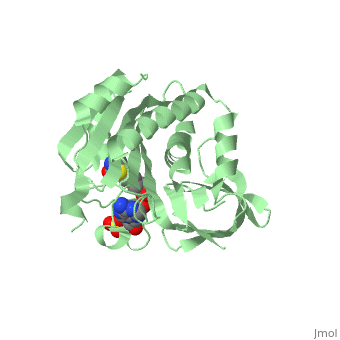4op0: Difference between revisions
No edit summary |
No edit summary |
||
| (6 intermediate revisions by the same user not shown) | |||
| Line 1: | Line 1: | ||
==Crystal structure of biotin protein ligase (RV3279C) of Mycobacterium tuberculosis, complexed with biotinyl-5'-AMP== | ==Crystal structure of biotin protein ligase (RV3279C) of Mycobacterium tuberculosis, complexed with biotinyl-5'-AMP== | ||
<StructureSection load='4op0' size='340' side='right' caption='[[4op0]], [[Resolution|resolution]] 1.70Å' scene=''> | <StructureSection load='4op0' size='340' side='right'caption='[[4op0]], [[Resolution|resolution]] 1.70Å' scene=''> | ||
== Structural highlights == | == Structural highlights == | ||
[[4op0]] is a 2 chain structure. Full crystallographic information is available from [http://oca.weizmann.ac.il/oca-bin/ocashort?id=4OP0 OCA]. <br> | <table><tr><td colspan='2'>[[4op0]] is a 2 chain structure with sequence from [https://en.wikipedia.org/wiki/Mycobacterium_tuberculosis_H37Rv Mycobacterium tuberculosis H37Rv]. Full crystallographic information is available from [http://oca.weizmann.ac.il/oca-bin/ocashort?id=4OP0 OCA]. For a <b>guided tour on the structure components</b> use [https://proteopedia.org/fgij/fg.htm?mol=4OP0 FirstGlance]. <br> | ||
<b>[[Ligand|Ligands:]]</b> <scene name='pdbligand=BT5:BIOTINYL-5-AMP'>BT5</scene>, <scene name='pdbligand=SO4:SULFATE+ION'>SO4</scene>< | </td></tr><tr id='method'><td class="sblockLbl"><b>[[Empirical_models|Method:]]</b></td><td class="sblockDat" id="methodDat">X-ray diffraction, [[Resolution|Resolution]] 1.7Å</td></tr> | ||
<tr id='ligand'><td class="sblockLbl"><b>[[Ligand|Ligands:]]</b></td><td class="sblockDat" id="ligandDat"><scene name='pdbligand=BT5:BIOTINYL-5-AMP'>BT5</scene>, <scene name='pdbligand=SO4:SULFATE+ION'>SO4</scene></td></tr> | |||
<b>Resources:</b> <span class='plainlinks'>[ | <tr id='resources'><td class="sblockLbl"><b>Resources:</b></td><td class="sblockDat"><span class='plainlinks'>[https://proteopedia.org/fgij/fg.htm?mol=4op0 FirstGlance], [http://oca.weizmann.ac.il/oca-bin/ocaids?id=4op0 OCA], [https://pdbe.org/4op0 PDBe], [https://www.rcsb.org/pdb/explore.do?structureId=4op0 RCSB], [https://www.ebi.ac.uk/pdbsum/4op0 PDBsum], [https://prosat.h-its.org/prosat/prosatexe?pdbcode=4op0 ProSAT]</span></td></tr> | ||
</table> | |||
== Function == | |||
[https://www.uniprot.org/uniprot/BIRA_MYCTU BIRA_MYCTU] Catalyzes the transfer of biotin onto a conserved lysine residue of the biotin carboxyl carrier protein (BCCP) domain of acetyl-CoA carboxylase and converts it to active holo-BCCP (PubMed:18509457, PubMed:24723382). Forms an acyl-adenylate intermediate (PubMed:18509457, PubMed:24723382). Cannot use GTP or desthiobiotin (PubMed:18509457).<ref>PMID:18509457</ref> <ref>PMID:24723382</ref> | |||
<div style="background-color:#fffaf0;"> | |||
== Publication Abstract from PubMed == | == Publication Abstract from PubMed == | ||
Protein biotinylation, a rare form of post-translational modification, is found in enzymes required for lipid biosynthesis. In mycobacteria, this process is essential for the formation of their complex and distinct cell wall and has become a focal point of drug discovery approaches. The enzyme responsible for this process, biotin protein ligase, substantially varies in different species in terms of overall structural organization, regulation of function and substrate specificity. To advance the understanding of the molecular mechanism of biotinylation in Mycobacterium tuberculosis we have biochemically and structurally characterized the corresponding enzyme. We report the high-resolution crystal structures of the apo-form and reaction intermediate biotinyl-5'-AMP-bound form of M. tuberculosis biotin protein ligase. Binding of the reaction intermediate leads to clear disorder-to-order transitions. We show that a conserved lysine, Lys138, in the active site is essential for biotinylation. | Protein biotinylation, a rare form of post-translational modification, is found in enzymes required for lipid biosynthesis. In mycobacteria, this process is essential for the formation of their complex and distinct cell wall and has become a focal point of drug discovery approaches. The enzyme responsible for this process, biotin protein ligase, substantially varies in different species in terms of overall structural organization, regulation of function and substrate specificity. To advance the understanding of the molecular mechanism of biotinylation in Mycobacterium tuberculosis we have biochemically and structurally characterized the corresponding enzyme. We report the high-resolution crystal structures of the apo-form and reaction intermediate biotinyl-5'-AMP-bound form of M. tuberculosis biotin protein ligase. Binding of the reaction intermediate leads to clear disorder-to-order transitions. We show that a conserved lysine, Lys138, in the active site is essential for biotinylation. | ||
| Line 11: | Line 16: | ||
Active site conformational changes upon reaction intermediate biotinyl-5'-AMP binding in biotin protein ligase from Mycobacterium tuberculosis.,Ma Q, Akhter Y, Wilmanns M, Ehebauer MT Protein Sci. 2014 Apr 9. doi: 10.1002/pro.2475. PMID:24723382<ref>PMID:24723382</ref> | Active site conformational changes upon reaction intermediate biotinyl-5'-AMP binding in biotin protein ligase from Mycobacterium tuberculosis.,Ma Q, Akhter Y, Wilmanns M, Ehebauer MT Protein Sci. 2014 Apr 9. doi: 10.1002/pro.2475. PMID:24723382<ref>PMID:24723382</ref> | ||
From | From MEDLINE®/PubMed®, a database of the U.S. National Library of Medicine.<br> | ||
</div> | |||
<div class="pdbe-citations 4op0" style="background-color:#fffaf0;"></div> | |||
==See Also== | |||
*[[Biotin Protein Ligase|Biotin Protein Ligase]] | |||
*[[Biotin Protein Ligase 3D structures|Biotin Protein Ligase 3D structures]] | |||
== References == | == References == | ||
<references/> | <references/> | ||
__TOC__ | __TOC__ | ||
</StructureSection> | </StructureSection> | ||
[[Category: | [[Category: Large Structures]] | ||
[[Category: | [[Category: Mycobacterium tuberculosis H37Rv]] | ||
[[Category: | [[Category: Akhter Y]] | ||
[[Category: | [[Category: Ma Q]] | ||
[[Category: | [[Category: Wilmanns M]] | ||
Latest revision as of 20:17, 20 September 2023
Crystal structure of biotin protein ligase (RV3279C) of Mycobacterium tuberculosis, complexed with biotinyl-5'-AMPCrystal structure of biotin protein ligase (RV3279C) of Mycobacterium tuberculosis, complexed with biotinyl-5'-AMP
Structural highlights
FunctionBIRA_MYCTU Catalyzes the transfer of biotin onto a conserved lysine residue of the biotin carboxyl carrier protein (BCCP) domain of acetyl-CoA carboxylase and converts it to active holo-BCCP (PubMed:18509457, PubMed:24723382). Forms an acyl-adenylate intermediate (PubMed:18509457, PubMed:24723382). Cannot use GTP or desthiobiotin (PubMed:18509457).[1] [2] Publication Abstract from PubMedProtein biotinylation, a rare form of post-translational modification, is found in enzymes required for lipid biosynthesis. In mycobacteria, this process is essential for the formation of their complex and distinct cell wall and has become a focal point of drug discovery approaches. The enzyme responsible for this process, biotin protein ligase, substantially varies in different species in terms of overall structural organization, regulation of function and substrate specificity. To advance the understanding of the molecular mechanism of biotinylation in Mycobacterium tuberculosis we have biochemically and structurally characterized the corresponding enzyme. We report the high-resolution crystal structures of the apo-form and reaction intermediate biotinyl-5'-AMP-bound form of M. tuberculosis biotin protein ligase. Binding of the reaction intermediate leads to clear disorder-to-order transitions. We show that a conserved lysine, Lys138, in the active site is essential for biotinylation. Active site conformational changes upon reaction intermediate biotinyl-5'-AMP binding in biotin protein ligase from Mycobacterium tuberculosis.,Ma Q, Akhter Y, Wilmanns M, Ehebauer MT Protein Sci. 2014 Apr 9. doi: 10.1002/pro.2475. PMID:24723382[3] From MEDLINE®/PubMed®, a database of the U.S. National Library of Medicine. See AlsoReferences
|
| ||||||||||||||||||
